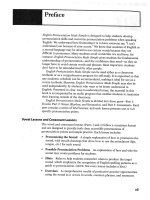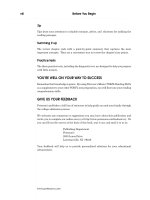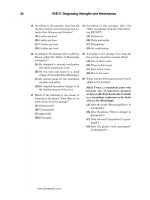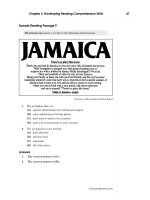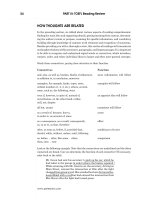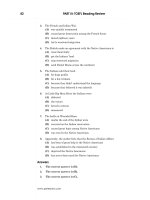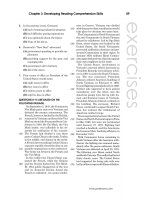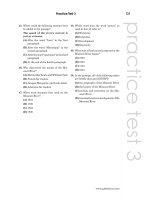READING JAPANESE - PART 2 pps
Bạn đang xem bản rút gọn của tài liệu. Xem và tải ngay bản đầy đủ của tài liệu tại đây (178.77 KB, 16 trang )
READING JAPANESE
十七
LESSON 1 SUMMARY
Below is the traditional order used for charting the kana syllabary. It's a 5 X 10 table of the “Fifty
Sounds”, or 五十音 (gozyuu-oñ). Usually the table runs from right to left and from top to bottom,
although other arrangements also occur. The following includes the katakana symbols which have
been introduced in this lesson within the basic framework of the五十音.
wa
ra
ya
ma
ha
na
ta
sa
ka
a
ワ
ラ
や
ナ
タ
カ
ア
ri
mi
hi
ni
ti
si
ki
i
リ
ミ
シ
イ
ru
yu
mu
hu
nu
tu
su
ku
u
ル
ス
ク
re
me
he
ne
te
se
ke
e
メ
テ
ro
yo
mo
ho
no
to
so
ko
o
ロ
モ
ホ
READING JAPANESE
十八
ROLOMAIL TRADING COMPANY
KATAKANA MOUSEPAD
READING JAPANESE
十九
LESSON 2
NOTES
The following are additional procedures to help identify loanwords that occur in this lesson.
1. Is there an occurrence of b in the romanized version of the loanword? Check it out for
representation of English 'v' as well as of 'b'.
Examples: boruga = 'Volga'
babaria = 'Bavaria'
2. Are there any occurrences of syllable to or do? Try eliminating the o.
Examples: toroi = 'Troy'
siatoru = 'Seattle'
raito = 'right' or 'light'
dorai = 'dry'
sadoru = 'saddle'
READING JAPANESE
二十
3. Is there an occurrence of z before a vowel? It may represent English 'th' as in 'then' as well as the
'z' sound in 'zebra'.
Examples: dezaato = 'dessert'
mazaa = 'mother'
And is there an occurrence of z before i? In this position, the z may also represent the initial sound
of ‘jeep’ or the medial consonantal sound of ‘Asia’, as well as the correspondences noted above.
Examples: baazinia = 'Virginia'
azia = 'Asia'
iizii = 'easy'
ziiai = 'G.I.'
4. Is there an occurrence of the vowel i? Try deleting it. Such deletion is particularly common in
word-final position and between voiceless consonants.
Examples: sutoraiki = 'strike'
paazi = 'purge'
tekisasu = 'Texas'
mekisiko = 'Mexico'
READING JAPANESE
二十一
5. The vowel u, when followed by a vowel, often represents English 'w', and ku before a vowel
corresponds to 'kw' (= 'qu').
Examples: kuizu = 'quiz'
sukuizu = 'squeeze'
6. Are there any occurrences of oo + consonant? Check them out for representation of English
vowel + 'r' of 'horse' as well as of the vowel sounds alone of 'mode' or 'Maud'.
Examples: noosu = 'north' or 'Norse'
noomaru = 'normal'
pooku = 'Pork' or 'Polk'
7. A vowel + syllable a may correspond to a vowel + 'r' sequence in English.
1
Examples: doa = 'door'
hea = 'hair'
1
Note that Japanese aa, discussed in Lesson 1, is an example of this same correspondence.
READING JAPANESE
二十二
SYMBOLS AND EXAMPLES
Katakana symbol:
Romanization
Stroke Order
オ
o
ト
to
ハ
ha
Examples:
オタワ otawa 'Ottawa' ラオス raosu 'Laos'
オスロ osuro 'Oslo' アイオワ aiowa 'Iowa'
スター sutaa 'star' オールスター oorusutaa 'all-star'
トロイ toroi 'Troy' シアトル siatoru 'Seattle'
オーストリア oosutoria 'Austria' オーストラリア oosutoraria 'Australia'
ライト raito 'light' or 'right' テールライト teeruraito 'taillight'
ハワイ hawai 'Hawaii' オハイオ ohaio 'Ohio'
ハリス harisu 'Harris' ハリー harii 'Harry'
ハイライト hairaito 'highlight' ハリー・ハリス harii・harisu 'Harry Harris'
ハイクラス haikurasu 'high class' ハイスクール haisukuuru 'high school'
READING JAPANESE
二十三
Katakana symbol:
Romanization
Stroke Order
ノ
no
サ
sa
Examples:
ハノイ hanoi 'Hanoi'
イリノイ irinoi 'Illinois'
ホノルル honoruru 'Honolulu'
ノース noosu 'North' or 'Norse'
ノア noa 'Noah'
ノラ nora 'Nora'
サハラ sahara 'Sahara'
サモア samoa 'Samoa'
サー saa 'Sir'
ミスター・ノア・ノース misutaa・noa・noosu 'Mr. Noah North'
ミス・ノラ・ノース misu・nora・noosu 'Miss Nora North'
サー・ルイス・ミラー saa・ruisu・miraa 'Sir Lewis Miller'
READING JAPANESE
二十四
Katakana symbol:
Romanization
Stroke Order
マ
ma
ニ
ni
ヤ
ya
Examples:
リマ rima 'Lima' マイアミ maiami 'Miami'
オクラホマ okurahoma 'Oklahoma' トーマス toomasu 'Thomas'
サマー samaa 'summer' クリスマス kurisumasu 'Christmas'
マラヤ maraya 'Malaya' ヤルタ yaruta 'Yalta'
ヤールー yaaruu 'Yalu'
トーマス・ノース toomasu・noosu 'Thomas North'
サマー・スクール samaa・sukuuru 'summer school'
メリー・リー・トーマス merii・rii・toomasu 'Mary Lee Thomas'
カール・マルクス kaaru・marukusu 'Karl Marx'
クリスマス・カロル kurisumasu・karoru 'Christmas carol'
READING JAPANESE
二十五
Katakana symbol:
Romanization
Stroke Order
ヒ
hi
レ
re
Examples:
ヒマラヤ himaraya 'Himalaya'
ヒール hiiru 'heel'
ハイヒール haihiiru 'high heel'
ローヒール roohiiru 'low heel'
マレーシア mareesia 'Malaysia'
レース reesu 'race' or 'lace'
オートレース ootoreesu 'auto race'
レーク reeku 'lake'
レーク・ホテル reeku・hoteru 'Lake Hotel'
レール reeru 'rail'
モノレール monoreeru 'monorail'
READING JAPANESE
二十六
Katakana symbol:
Romanization
Stroke Order
コ
ko
キ
ki
Examples:
メキシコ mekisiko 'Mexico'
コスタリカ kosutarika 'Costa Rica'
コスト kosuto 'cost'
ローコスト rookosuto 'low cost'
コースター koosutaa 'coaster'
ローラーコースター rooraakoosutaa 'roller coaster'
コーク kooku 'coke'
コーラ koora 'cola'
コカコーラ kokakoora 'Coca Cola'
テキサス tekisasu 'Texas'
キロサイクル kirosaikuru 'kilocycle'
キロメートル kiromeetoru 'kilometer'
READING JAPANESE
二十七
ADDITIONAL PRACTICE
1. ノー
2. ハロー
3. アロハ
4. オーライ
5. コート
6. サラミ
7. レタス
8. テニス
9. スキー
10. レスラー
11. ハイク
12. サーカス
13. オート
14. トラクター
15. ハイヤー
16. ヒーター
17. タオル
18. サラリー
1. noo 'no'
2. haroo 'hello'
3. aroha 'aloha'
4. oorai 'awri[ght]'
(i.e., 'all right')
5. kooto 'coat'
6. sarami 'salami'
7. retasu 'lettuce'
8. tenisu 'tennis'
9. sukii 'ski[ing]'
10. resuraa 'wrestler'
11. haiku 'hike'
12. saakasu 'circus'
13. ooto 'auto'
14. torakutaa 'tractor'
15. haiyaa '[car for] hire'
16. hiitaa 'heater'
17. taoru 'towel'
18. sararii 'salary'
READING JAPANESE
二十八
19. レシート
20. トータル
21. ノート
22. サークル
23. ステレオ
24. マイク
25. オスカー
26. コーラス
27. キリスト
28. ハレルヤ
29. ヒーロー
30. ハート
31. スイートハート
32. キス
33. ノーマル
34. トラスト
35. ストライク
36. スト(ライキ)
19. resiito 'receipt'
20. tootaru 'total'
21. nooto 'note'
22. saakuru 'circle'
23. sutereo 'stereo'
24. maiku 'mic[rophone]'
25. osukaa 'Oscar'
26. koorasu 'chorus'
27. kirisuto 'Christ'
28. hareruya 'halleluja'
29. hiiroo 'hero'
30. haato 'heart' (card suit)
31. suiitohaato 'sweetheart'
32. kisu 'kiss'
33. noomaru 'normal'
34. torasuto 'trust'
35. sutoraiku '(baseball) strike'
36. suto or sutoraiki '(protest) strike'
READING JAPANESE
二十九
DIACRITICS
1(a) Compare the following pairs of symbols:
タ and ダ
テ and デ
ト and ド
The symbols on the left are already familiar. They are equivalent to the romanized syllables ta, te,
and to. The corresponding symbols on the right are equivalent to the romanized syllables da, de, and
do. In other words, the addition of a ゛(called nigori
1
) to a kana symbol which represents a syllable
with an initial t- changes its value to the corresponding syllable beginning with d
Compare: トライ torai 'try'
ドライ dorai 'dry'
1
The green letter ‘g’ in nigori is a convention used solely in this text to represent a nasal pronunciation of ‘g’, as in the 'ng' of 'singer',
produced by holding the tongue in the g position, but allowing the air to escape through the nostrils. This type of 'g' sound never
occurs in the beginning of a word. The ‘g‘ sound is considered an aspect of the 'Tokyo dialect', though many Tokyo residents use the
regular ‘g’ sound instead, and still others alternate between the two forms. Hence, where ‘g’ is written, ‘g’ can always be used, but
where ‘g’ is written, ‘g’ cannot be used.
READING JAPANESE
三十
Examples:
ダ da
ダラス darasu ‘Dallas’
アイダホ aidaho ‘Idaho’
ノースダコタ noosudakota ‘North Dakota’
デ de
デリー derii 'Delhi'
デトロイト detoroito 'Detroit'
ド do
ドミニカ dominika 'Dominica[n Republic]'
カード kaado 'card'
クリスマス・カード kurisumasu・kaado 'Christmas card'
READING JAPANESE
三十一
ADDITIONAL PRACTICE
New Words:
1. ダイヤ
2. ダイアリー
3. ダイレクト・メール
4. デモ
5. データ
6. デート
7. デスカ
8. デモクラシー
9. メー・デー
10. ドル
11. ドア
12. サドル
13. ドラマ
14. ドクター
15. ドライヤー
16. ドライアイス
17. サイドワーク
18. サイドスロー
1. daiya 'dia[mond]'
2. daiarii 'diary'
3. dairekuto・meeru 'direct mail'
4. demo 'demo[nstration]'
5. deeta 'data'
6. deeto 'date'
7. desuku 'desk'
8. demokurasii 'democracy'
9. mee・dee 'May Day'
10. doru 'doll[ar]'
11. doa 'door'
12. sadoru 'saddle'
13. dorama 'drama'
14. dokutaa 'doctor'
15. doraiyaa 'dryer'
16. doraiaisu 'dry ice'
17. saidowaaku 'side work'
(side job)
18. saidosuroo 'side throw'
(as in baseball)
READING JAPANESE
三十二
(b) The addition of nigori to kana symbols representing syllables with initial k- changes the value to
the corresponding syllables beginning with g- / or -g-
1
/.
Compare: コースト koosuto 'coast'
ゴースト goosuto 'ghost'
Examples:
ガ ga / or –ga /
マダガスカル madagasukaru 'Madagascar'
グ gu / or –gu /
グアテマラ guatemara 'Guatemala'
ニカラグア nikaragua 'Nicaragua'
ギ gi / or –gi /
イギリス igirisu 'England'
ギニア ginia 'Guinea'
ゴ go / or –go /
シカゴ sikago 'Chicago'
グラスゴー gurasugoo 'Glascow'
1
The -g- alternant is comparatively rare in loanwords.


